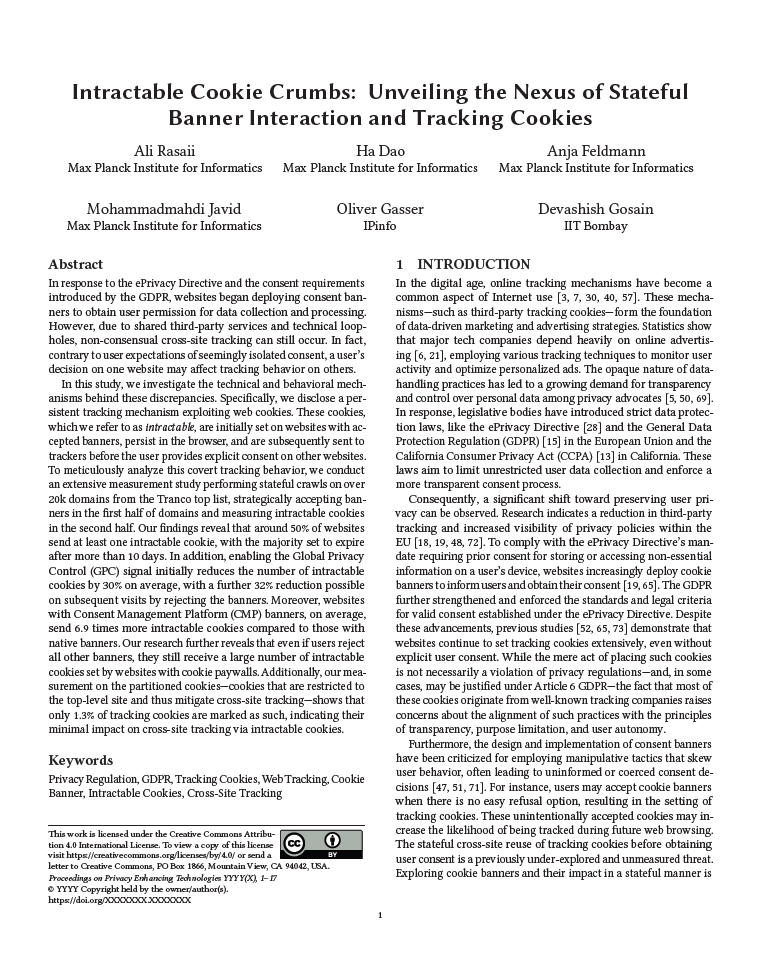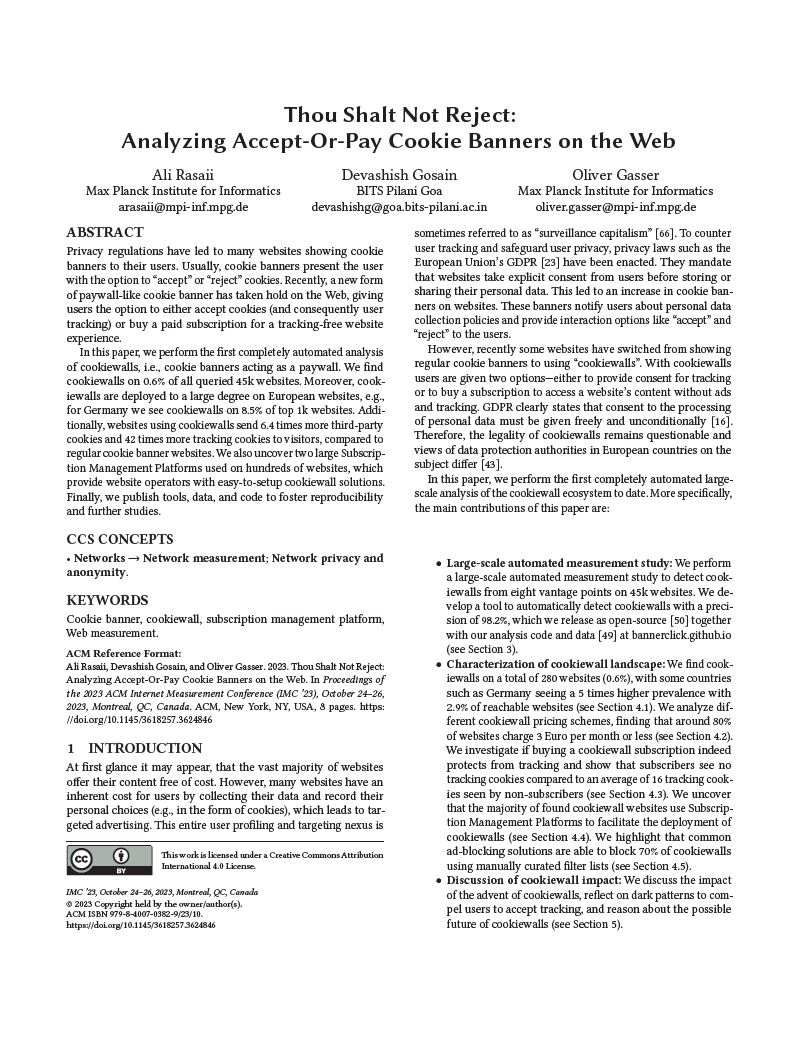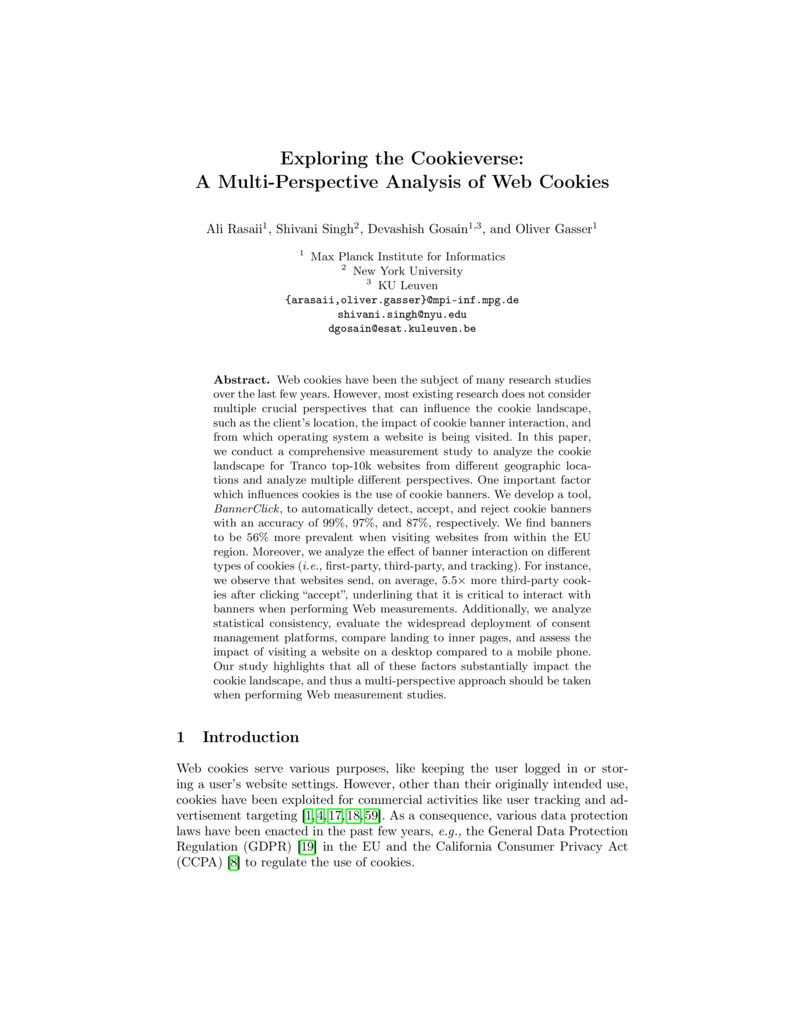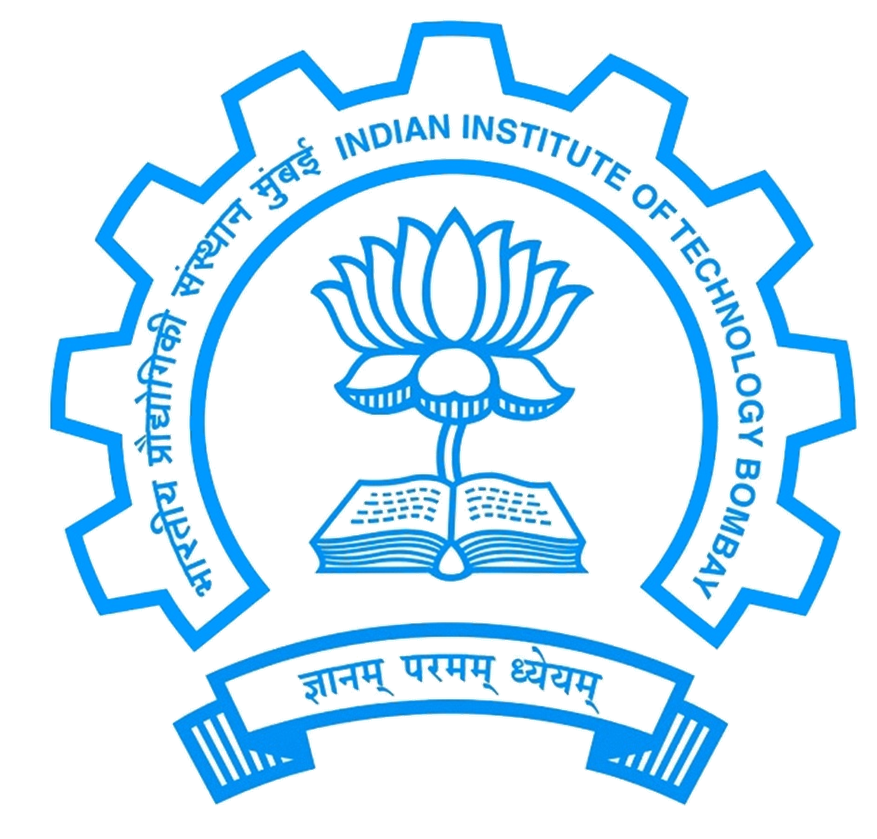On this website we present three of our papers published at the PAM23, IMC23, and PETS25 as well as the tool BannerClick.
Cookie Crumbs: The Nexus of Banner Interaction and Tracking Cookies
Papers
Intractable Cookie Crumbs: Unveiling the Nexus of Stateful Banner Interaction and Tracking Cookies
Proceedings of the 25th Privacy Enhancing Technologies Symposium (PETS 2025)

Abstract. In response to the ePrivacy Directive and the consent requirements introduced by the GDPR, websites began deploying consent banners to obtain user permission for data collection and processing. However, due to shared third-party services and technical loopholes, non-consensual cross-site tracking can still occur. In fact, contrary to user expectations of seemingly isolated consent, a user's decision on one website may affect tracking behavior on others. In this study, we investigate the technical and behavioral mechanisms behind these discrepancies. Specifically, we disclose a persistent tracking mechanism exploiting web cookies. These cookies, which we refer to as intractable, are initially set on websites with accepted banners, persist in the browser, and are subsequently sent to trackers before the user provides explicit consent on other websites. To meticulously analyze this covert tracking behavior, we conduct an extensive measurement study performing stateful crawls on over 20k domains from the Tranco top list, strategically accepting banners in the first half of domains and measuring intractable cookies in the second half. Our findings reveal that around 50% of websites send at least one intractable cookie, with the majority set to expire after more than 10 days. In addition, enabling the Global Privacy Control (GPC) signal initially reduces the number of intractable cookies by 30% on average, with a further 32% reduction possible on subsequent visits by rejecting the banners. Moreover, websites with Consent Management Platform (CMP) banners, on average, send 6.9 times more intractable cookies compared to those with native banners. Our research further reveals that even if users reject all other banners, they still receive a large number of intractable cookies set by websites with cookie paywalls. Additionally, our measurement on the partitioned cookies — cookies that are restricted to the top-level site and thus mitigate cross-site tracking — shows that only 1.3% of tracking cookies are marked as such, indicating their minimal impact on cross-site tracking via intractable cookies.
Authors. Ali Rasaii, Ha Dao, Anja Feldmann, Mohammadmahdi Javid, Oliver Gasser and Devashish Gosain.
Thou Shalt Not Reject: Analyzing Accept-Or-Pay Cookie Banners on the Web
ACM Internet Measurement Conference 2023 (IMC23)

Abstract. Privacy regulations have led to many websites showing cookie banners to their users. Usually, cookie banners present the user with the option to “accept” or “reject” cookies. Recently, a new form of paywall-like cookie banner has taken hold on the Web, giving users the option to either accept cookies (and consequently user tracking) or buy a paid subscription for a tracking-free website experience. In this paper, we perform the first completely automated analysis of cookiewalls, i.e., cookie banners acting as a paywall. We find cookiewalls on 0.6% of all queried 45k websites. Moreover, cookiewalls are deployed to a large degree on European websites, e.g., for Germany we see cookiewalls on 8.5% of top 1k websites. Additionally, websites using cookiewalls send 6.4 times more third-party cookies and 42 times more tracking cookies to visitors, compared to regular cookie banner websites. We also uncover two large Subscription Management Platforms used on hundreds of websites, which provide website operators with easy-to-setup cookiewall solutions. Finally, we plan to publish tools, data, and code to foster reproducibility and further studies.
Authors. Ali Rasaii, Devashish Gosain, and Oliver Gasser.
Exploring the Cookieverse: A Multi-Perspective Analysis of Web Cookies
Passive and Active Measurement Conference 2023 (PAM23)

Abstract. Web cookies have been the subject of many research studies over the last few years. However, most existing research does not consider multiple crucial perspectives that can influence the cookie landscape, such as the client’s location, the impact of cookie banner interaction, and from which operating system a website is being visited. In this paper, we conduct a comprehensive measurement study to analyze the cookie landscape for Tranco top-10k websites from different geographic locations and analyze multiple different perspectives. One important factor which influences cookies is the use of cookie banners. We develop a tool, BannerClick , to automatically detect and interact with cookie banners with an accuracy of 99% and 96%, respectively. We find banners to be 56% more prevalent when visiting websites from within the EU region. Moreover, we analyze the effect of banner interaction on different types of cookies (i.e., first-party, third-party, and tracking). For instance, we observe that websites send, on average, 5.5× more third-party cookies after clicking “accept”, underlining that it is critical to interact with banners when performing Web measurements. Additionally, we analyze statistical consistency, evaluate the widespread deployment of consent management platforms, compare landing to inner pages, and assess the impact of visiting a website on a desktop compared to a mobile phone. Our study highlights that all of these factors substantially impact the cookie landscape, and thus a multi-perspective approach should be taken when performing Web measurement studies.
Authors. Ali Rasaii, Shivani Singh, Devashish Gosain, and Oliver Gasser.
Reproducibility
We publish data and scripts to reproduce our analysis at the Open Research Data Repository of the Max Planck Society to guarantee long-term availability.
Dataset DOI. (PETS paper) 10.17617/3.QZCILK
Dataset DOI. (IMC paper) 10.17617/3.TREBZR
Dataset DOI. (PAM paper) 10.17617/3.1MUYFX
Contact
You can contact us at bannerclick@mpi-inf.mpg.de.




